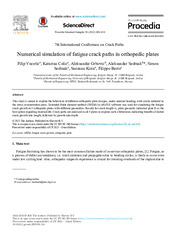Prikaz osnovnih podataka o dokumentu
Numerical simulation of fatigue crack paths in orthopedic plates
| dc.creator | Vučetić, Filip | |
| dc.creator | Čolić, Katarina | |
| dc.creator | Grbović, Aleksandar | |
| dc.creator | Sedmak, Aleksandar | |
| dc.creator | Sedmak, Simon | |
| dc.creator | Kirin, Snežana | |
| dc.creator | Berto, Filippo | |
| dc.date.accessioned | 2022-09-19T19:22:49Z | |
| dc.date.available | 2022-09-19T19:22:49Z | |
| dc.date.issued | 2021 | |
| dc.identifier.issn | 2452-3216 | |
| dc.identifier.uri | https://machinery.mas.bg.ac.rs/handle/123456789/3635 | |
| dc.description.abstract | This study is aimed to explain the behaviour of different orthopedic plate designs, under uniaxial bending, with cracks initiated in the stress concentration areas. Extended finite element method (XFEM) in ANSYS software was used for simulating the fatigue crack growth in 5 orthopedic plates with different geometries. Results for crack length vs, plate geometry indicated plate D as the best option regarding residual life. Crack paths are analysed in all 5 plates to explain such a behaviour, indicating benefits of initial crack growth into length, followed by growth into depth. | en |
| dc.publisher | Elsevier B.V. | |
| dc.relation | info:eu-repo/grantAgreement/MESTD/inst-2020/200105/RS// | |
| dc.rights | openAccess | |
| dc.rights.uri | https://creativecommons.org/licenses/by-nc-nd/4.0/ | |
| dc.source | Procedia Structural Integrity | |
| dc.subject | xFEM | en |
| dc.subject | orthopedic plate | en |
| dc.subject | fatigue crack growth | en |
| dc.title | Numerical simulation of fatigue crack paths in orthopedic plates | en |
| dc.type | conferenceObject | |
| dc.rights.license | BY-NC-ND | |
| dc.citation.epage | 814 | |
| dc.citation.issue | C | |
| dc.citation.other | 39(C): 808-814 | |
| dc.citation.spage | 808 | |
| dc.citation.volume | 39 | |
| dc.identifier.doi | 10.1016/j.prostr.2022.03.154 | |
| dc.identifier.fulltext | http://machinery.mas.bg.ac.rs/bitstream/id/2207/3632.pdf | |
| dc.identifier.scopus | 2-s2.0-85127354197 | |
| dc.type.version | publishedVersion |


